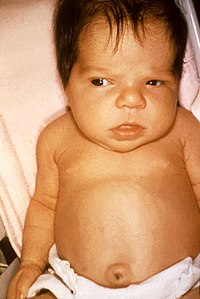
Photo from wikipedia
Introduction Optimizing outcome in biliary atresia (BA) requires timely diagnosis. Cholestasis is a presenting feature of BA, as well as other diagnoses (Non-BA). Identification of clinical features of neonatal cholestasis… Click to show full abstract
Introduction Optimizing outcome in biliary atresia (BA) requires timely diagnosis. Cholestasis is a presenting feature of BA, as well as other diagnoses (Non-BA). Identification of clinical features of neonatal cholestasis that would expedite decisions to pursue subsequent invasive testing to correctly diagnose or exclude BA would enhance outcomes. The analytical goal was to develop a predictive model for BA using data available at initial presentation. Methods Infants at presentation with neonatal cholestasis (direct/conjugated bilirubin >2 mg/dl [34.2 μM]) were enrolled prior to surgical exploration in a prospective observational multi-centered study (PROBE–NCT00061828). Clinical features (physical findings, laboratory results, gallbladder sonography) at enrollment were analyzed. Initially, 19 features were selected as candidate predictors. Two approaches were used to build models for diagnosis prediction: a hierarchical classification and regression decision tree (CART) and a logistic regression model using a stepwise selection strategy. Results In PROBE April 2004-February 2014, 401 infants met criteria for BA and 259 for Non-BA. Univariate analysis identified 13 features that were significantly different between BA and Non-BA. Using a CART predictive model of BA versus Non-BA (significant factors: gamma-glutamyl transpeptidase, acholic stools, weight), the receiver operating characteristic area under the curve (ROC AUC) was 0.83. Twelve percent of BA infants were misclassified as Non-BA; 17% of Non-BA infants were misclassified as BA. Stepwise logistic regression identified seven factors in a predictive model (ROC AUC 0.89). Using this model, a predicted probability of >0.8 (n = 357) yielded an 81% true positive rate for BA; <0.2 (n = 120) yielded an 11% false negative rate. Conclusion Despite the relatively good accuracy of our optimized prediction models, the high precision required for differentiating BA from Non-BA was not achieved. Accurate identification of BA in infants with neonatal cholestasis requires further evaluation, and BA should not be excluded based only on presenting clinical features.
Journal Title: PLoS ONE
Year Published: 2017
Link to full text (if available)
Share on Social Media: Sign Up to like & get
recommendations!